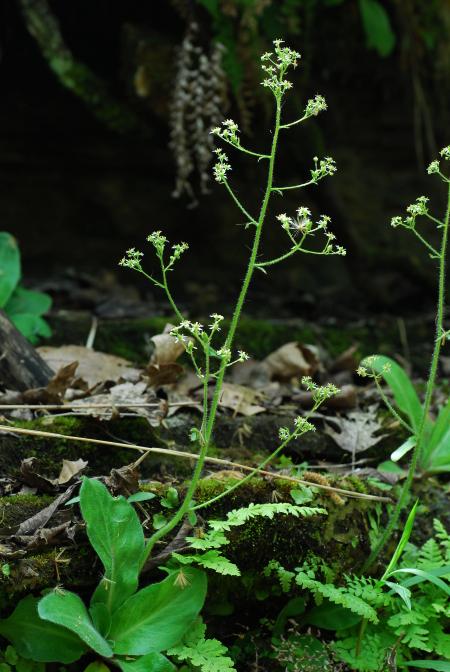Micranthes pensylvanica (L.) Haw.
Forbes' Saxifrage

Native
CC = 10
CW = 0
MOC = 10
© SRTurner
Micranthes pensylvanica (L.) Haw.Forbes' Saxifrage | |
 |
Native CC = 10 CW = 0 MOC = 10 |
© SRTurner |
|
Family - Saxifragaceae Habit - Perennial forb with rhizomes and fibrous roots. Roots fleshy and translucent. Stems - Leaves and aerial stems arising from a caudex. Leaves - Leaves in a basal rosette, spatulate, pilose above and below, less so above, tapered at the base to a reddish-purple short petiole, crenate to crenulate, rounded to acute at the apex, to +25cm long, +8cm broad.
Inflorescence - Panicle of clustered cymules terminating the flowering scape. Each branch of the panicle subtended by a linear-oblong bract. Bracts reduced upward, glandular pilose abaxially, glabrous adaxially, entire. Peduncles of cymules densely glandular hirsute, the glands reddish (use a lens to see). Each division of the cymules and each flower subtended by a small bract. Pedicels of the flowers +/-2mm long in flower. glandular-hirsute as the peduncles.
Flowers - Petals 5, white to greenish, distinct, lanceolate, glabrous, acute, 5mm long, to 1.5mm broad. Stamens 10, arising at the base of the petals and sepals, distinct, spreading to erect. Filaments translucent-white, to 1.5mm long, glabrous. Anthers orange when fresh, .4-.5mm long. Styles 2, expanded greatly at the base, divided all the way to the base, recurving at the apices, to 2mm long, glabrous, green. Stigmas small, translucent. Ovary swollen, green, glabrous, partially inferior, 2-carpeled. Placentation axile. Hypanthium pale green, obconic, 2-2.5mm long, glabrous. Sepals 5, green, glabrous, spreading, to 3mm long, 1.5mm broad, subulate, with reddish apices.
Fruits - Capsules 3.5-5.5 mm long, ovoid, 2-beaked, dehiscing longitudinally along the inner suture of each beak, the free tips divergent.
Flowering - April - June. Habitat - Moist, north-facing sandstone bluffs. Typically on St. Peter sandstone but sometimes found on other types of sandstone. Origin - Native to the U.S. Lookalikes - None when flowering. Other info. - This species can be found in the east-central portion of Missouri and is fairly exclusive to the habitat mentioned above. Its North American distribution is largely confined to the upper Midwest. The plants grow directly from the sides of cracks in the sandstone or in the thin layer of litter settled upon the rock. The basal leaves of the plant emerge very early in the spring and flowering occurs about a month later. Photographs taken at Danville Conservation Area, Montgomery County, MO., 4-8-04 (DETenaglia); also at Klondike County Park, St. Charles, MO, 5-6-2013, Danville Conservation Area, Montgomery County, MO, 4-25-2017 and 5-6-2017, and Pacific Palisades Conservation Area, MO, 4-21-2025 (SRTurner). |